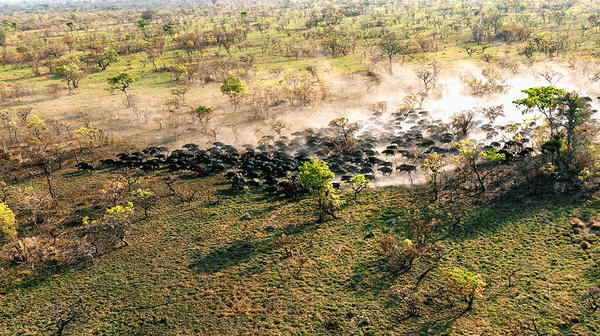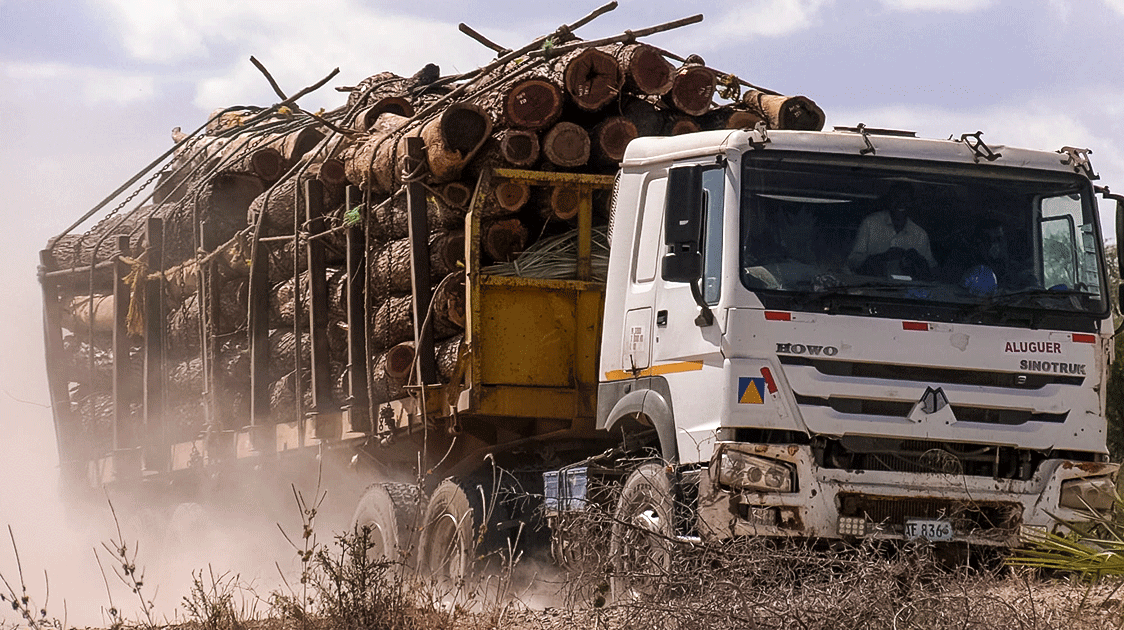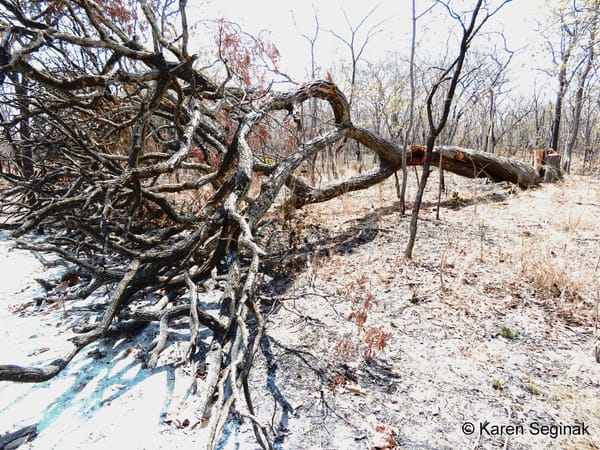The Threat of Timber Poaching in Africa
Executive Summary
African countries are estimated to lose $17 billion to illegal logging each year, making timber poaching one of the continent's most pressing conservation and security challenges.
Research conducted by WWF International in 2002 reveals that in Africa, rates of illegal logging range from 50% in Cameroon and Equatorial Guinea to 70% in Gabon and 80% in Liberia.
This crisis extends far beyond environmental damage, directly funding criminal networks, militias, and terrorist groups while undermining legitimate governance and economic development across the continent.
The Scale of the Crisis
Timber poaching in Africa operates on a massive scale that rivals other forms of organized crime. Illegal logging and forest crime are estimated to have a worth of US$30 to US$100 billion annually, accounting for 10% to 30% of the total global timber trade.
The impact is particularly severe in specific regions, with over 1.4 million Kosso (rosewood) logs, worth approximately US$300 million, illegally sourced from Cameroon, being shipped to China through Nigeria in 2017.
The environmental consequences are equally staggering. Illegal logging destroys the same forests that nearly 80 per cent of the world's known terrestrial plant and animal species rely on to survive, while simultaneously undermining the carbon sequestration capacity that is crucial for maintaining climate stability.
Key Drivers and Criminal Networks
The primary driver of illegal logging in Africa is international demand, particularly from Asian markets. The most significant driver of the illicit logging in Africa is the Chinese market for teak, redwood, and mahogany. This demand has created sophisticated criminal networks that exploit weak governance structures and porous borders.
Organized criminal activity can occur at any stage of the supply chain, including extraction, milling, transportation, marketing, or profit laundering. These networks operate through multiple pathways:
- Artisanal extractors who supply high-value wood to trafficking groups with minimal oversight
- State-embedded actors who facilitate operations through corruption and false documentation
- Foreign actors who provide financing and market access
- Cross-border laundering where timber is falsely declared to be legal
Connection to Armed Conflict and Terrorism
Perhaps most alarmingly, timber poaching directly funds armed groups and terrorist organizations across Africa. When the Seleka rebel coalition took over in the Central African Republic (CAR) in 2013-14, international timber traders paid them at least 3.4 million euros in protection fees to continue their harvesting and exporting operations.
Similar patterns emerge across the continent:
- In the DRC, the Allied Democratic Forces and several other militant groups in the east have been involved in the illegal timber trade, which serves as a conflict financing mechanism
- In Senegal, where there has been a low-level insurgency since 1982, the Movement of Democratic Forces of Casamance (MFDC) has sustained its operations almost entirely through profits from the illicit logging of rosewood
Regional Hotspots and Transit Routes
Several regions have emerged as critical focal points for illegal logging activities:
Central Africa
The Congo Basin forests face particularly intense pressure, with Uganda serving as a transit hub for approximately 80 percent of the illegal timber from the Democratic Republic of the Congo (DRC) that passes through East Africa. Countries such as Cameroon, Equatorial Guinea, Gabon, and the Republic of the Congo have become significant exporters of illegally harvested timber.
West Africa
Nigeria has transitioned from a source country to a major transit hub, with significant quantities of this timber sourced from Cameroon as Nigeria's timber resources become depleted.
Enforcement Challenges
The fight against timber poaching faces significant obstacles that parallel those encountered in traditional anti-poaching operations, as detailed in our coverage of anti-poaching operations across Africa. Key challenges include:
- Limited resources for monitoring vast forest areas
- Corruption among officials and border guards
- Sophisticated laundering schemes that make detection difficult
- Weak prosecution and sentencing frameworks, similar to issues highlighted in our analysis of prosecuting snare poachers
Conservation and Security Implications
The interconnected nature of environmental crime means that timber poaching often occurs alongside wildlife trafficking. Apart from poaching, Africa loses approximately USD 17 billion annually towards illegal logging activities as the demand for timber is at an all-time high. This creates compounded pressure on protected areas and wildlife corridors, themes explored in our field reports on poaching corridors.
Twenty-six mammal species are classified as endangered or critically endangered in the country's rainforests, largely due to the illegal trafficking of timber, which demonstrates how forest destruction directly threatens biodiversity.
Technology and Response Strategies
Similar to the anti-poaching efforts documented in our field reports, combating timber poaching is increasingly relying on technological solutions. APET is also urging African countries to adopt artificial intelligence and drone technologies to protect wildlife efficiently, with applications extending to forest monitoring and the detection of illegal logging.
Effective strategies include:
- Satellite monitoring for real-time deforestation tracking
- Advanced wood identification technologies to verify species and origin
- Strengthened certification systems for legal timber
- Community engagement programs that provide alternative livelihoods
Economic Impact and Alternative Solutions
The economic dimensions of timber poaching reflect broader challenges in Africa's wildlife economy, topics we explore in our analysis of Sustainable Development Goals and the Wildlife Economy. Africa has persistent wildlife crimes that are particularly deterring Africa's efforts towards wildlife conservation.
Like legitimate conservation hunting operations detailed in our Cameroon field reports, sustainable forest management can provide economic benefits while protecting ecosystems.
The Path Forward
Addressing timber poaching requires the same integrated approach advocated for wildlife conservation: combining enforcement with community engagement, international cooperation, and sustainable economic alternatives. The governments of five African countries committed this week to curtail the illegal and unsustainable timber trade through the Zanzibar Declaration, demonstrating growing political will to tackle this challenge.
Success will require:
- Strengthened law enforcement with adequate resources and training
- International cooperation to disrupt trafficking networks
- Community-based forest management that provides a legitimate income
- Consumer awareness in destination markets
- Integrated approach linking anti-poaching and anti-logging efforts
The fight against timber poaching is inextricably linked to broader conservation efforts across Africa. As our field reports consistently demonstrate, effective conservation requires a sustained commitment, adequate resources, and recognition that environmental crimes threaten not only wildlife and forests, but also regional security and economic development.
Frequently Asked Questions
How does timber poaching differ from wildlife poaching?
While wildlife poaching targets animals for their valuable parts (ivory, rhino horn, bushmeat), timber poaching focuses on illegally harvesting high-value tree species. However, both crimes often operate through the same criminal networks and frequently occur in the same areas. Organized criminal activity can happen at any stage of the supply chain, including extraction, milling, transportation, marketing, or profit laundering, making timber poaching as sophisticated as wildlife trafficking operations.
Which tree species are most targeted by poachers?
The most sought-after species include rosewood (Kosso), teak, mahogany, and other rare hardwoods. Africa's share of rosewood exports to China increased from 40% in 2008 to 90% in 2018, highlighting the intense pressure on these species. These trees often take decades or centuries to mature, making their illegal harvesting particularly devastating.
How do timber poachers launder their illegal products?
Timber laundering involves several sophisticated methods:
- False documentation declaring illegal timber as legally harvested
- Species misidentification to pass off high-value species as common varieties
- Cross-border laundering where timber crosses multiple borders to obscure its origin
- Mixing illegal timber with legally harvested wood to mask its source
- Processing transformation, where once wood is processed into pulp, only laboratory analysis can reveal the species and country of origin
Are local communities involved in timber poaching?
Local communities often participate due to economic necessity, but they typically receive minimal compensation compared to the enormous profits generated higher up the supply chain. Artisanal or small-scale loggers are normally the extractors of high-value wood that supply trafficking groups. Successful anti-timber poaching programs, such as those documented in our Cameroon operations, focus on providing alternative livelihoods rather than relying solely on punitive approaches.
How do rangers detect illegal logging in remote areas?
Detection methods mirror anti-poaching techniques covered in our field reports:
- Satellite monitoring for real-time deforestation alerts
- Drone surveillance with thermal imaging capabilities
- Ground patrols by trained forest guards
- Community reporting systems similar to the WhatsApp hotlines used for wildlife crime
- Acoustic monitoring to detect chainsaw activity in protected areas
Can consumers help combat timber poaching?
Yes, consumer awareness and purchasing decisions play a crucial role in shaping the market. Look for certified sustainable timber products (FSC certification), avoid purchasing items made from endangered wood species, and support companies with transparent supply chains. Traces of illegally logged African timber are found in products in living rooms, kitchens and bedrooms across the US, making consumer education vital.
How is timber poaching connected to terrorism and armed conflict?
In the Central African Republic, international timber traders paid the Seleka rebel coalition at least 3.4 million euros in protection fees. Meanwhile, in Senegal, the Movement of Democratic Forces of Casamance has sustained its operations almost entirely through profits from illicit rosewood logging. This makes timber poaching a significant security threat, in addition to its environmental impact.
How You Can Help Combat Timber Poaching
Support Field Operations
Just as our Zimbabwe anti-poaching reports detail the critical need for operational support, anti-timber poaching efforts require similar backing:
Equipment Donations:
- GPS devices for tracking patrol routes and illegal activity
- Communication equipment, including satellite phones and radio systems
- Vehicles and fuel for accessing remote forest areas
- Chainsaws and tools for removing illegal equipment and barriers
- Camping gear for extended forest patrols
Technology Support:
- Drone funding for aerial surveillance of vast forest areas
- Camera traps for monitoring logging activity
- Solar panels for powering remote monitoring stations
- Satellite connectivity for real-time reporting from the field
Community Engagement Programs
Alternative Livelihood Projects:
- Sustainable forestry training for local communities
- Eco-tourism development in forest areas
- Beekeeping and non-timber forest products as income alternatives
- Tree nursery establishment for reforestation efforts
Education Initiatives:
- School programs about forest conservation
- Community workshops on sustainable resource use
- Women's groups focused on forest protection
- Youth engagement in conservation activities
Policy and Advocacy Support
Research and Documentation:
- Fund field research into timber trafficking networks
- Support investigative journalism exposing illegal operations
- Document success stories from effective programs
- Map trafficking routes and criminal networks
Legal Framework Enhancement:
- Support more substantial penalties for timber crimes
- Advocate for better prosecution of environmental crimes
- Promote international cooperation agreements
- Push for corporate accountability in supply chains
Direct Financial Support
Priority Funding Needs:
- Ranger salaries for full-time forest protection teams
- Vehicle maintenance for patrol operations
- Fuel costs for reaching remote areas
- Equipment replacement as gear wears out in harsh conditions
- Emergency response funds for urgent situations
Long-term Investment:
- Training programs for forest guards and law enforcement
- Infrastructure development, including ranger stations and communication networks
- Community development projects that reduce dependence on illegal logging
- Capacity building for local conservation organizations
Corporate Partnership Opportunities
Supply Chain Transparency:
- Implement tracking systems for timber products
- Conduct due diligence on supplier practices
- Support certification programs for sustainable timber
- Invest in alternative materials to reduce pressure on high-value species
Technology Development:
- Fund innovation in wood identification technology
- Develop blockchain solutions for supply chain tracking
- Support AI applications for satellite monitoring
- Create apps for community reporting of illegal activity
Consumer Actions
Responsible Purchasing:
- Choose certified products with FSC or similar certification
- Avoid endangered wood species in furniture and construction
- Research company practices before major purchases
- Support sustainable alternatives to tropical hardwoods
Awareness Building:
- Share information about timber poaching impacts
- Educate others about sustainable choices
- Support conservation organizations working on this issue
- Advocate for policy changes in your community
Getting Involved with Field Operations
While direct participation in anti-timber poaching patrols requires specialized training and security clearance, there are several ways to engage with field operations:
Volunteer Opportunities:
- Data analysis and mapping support from remote locations
- Social media management for conservation organizations
- Fundraising coordination for specific projects
- Photography and documentation during approved visits
Professional Contributions:
- Legal expertise for prosecution support
- Technical skills in GIS mapping and satellite analysis
- Journalism and communication to raise awareness
- Academic research collaboration with field teams
Your support directly enhances the capabilities for preventing timber poaching across Africa. Every contribution, whether financial, technical, or advocacy-based, enhances the capacity of rangers and communities to protect these vital forest ecosystems. For real-time updates from the field and specific funding opportunities, explore our multimedia reports on conservation operations across the continent.




